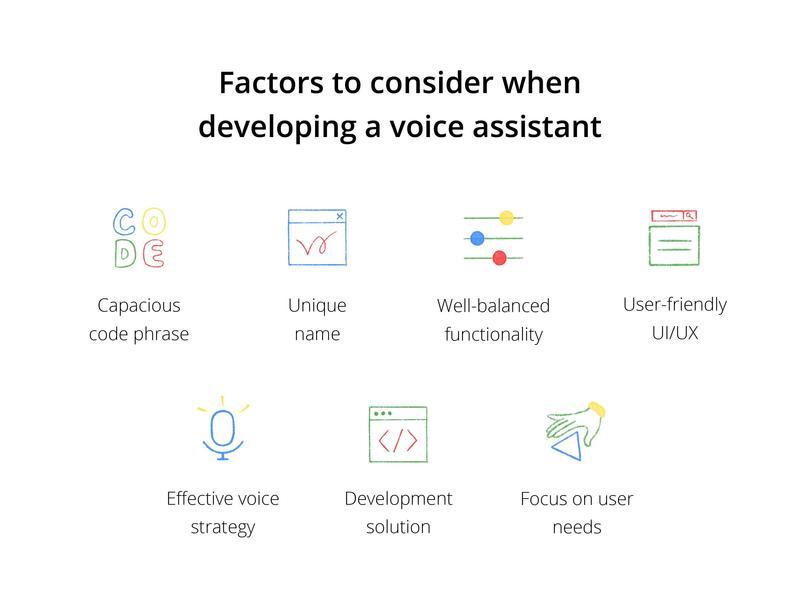“Siri, show me the weather forecast!” - you ask your device, and the request is immediately fulfilled. And there is no need to dig through the phone yourself to check weather conditions or read the latest news (or whatever!).
It's a familiar situation, and we've all been there, right? Many of us are used to turning to digital assistants to set an alarm-clock, find some information on the Internet, or perform another simple action of the same sort.
This is possible through innovative technologies, which have entered almost every home (and pocket) in the 21st century. And speaking of virtual assistants, these cool solutions not only greatly simplified our daily lives but also became an integral part of most business models.
Interested in details? To be precise, do you want to know the various advantages of the integration of voice technology? Then we suggest reading our article.
Some statistics on voice assistants
Let's start with the reasons why virtual assistant app development is a cool idea that would benefit your business. The best thing is to resort to the latest statistics:
-
According to research, the global intelligent virtual assistant market size is projected to hit around USD 129.61 billion by 2032.
-
As Pew Research claims, more than 45% of US residents take advantage of virtual assistants regularly (and 42% of them use mobile devices).
-
More than 60% of Britons use voice assistants to search or shop online, as well as listen to their favorite tracks.
But maybe you don't know what we're talking about, do you? What is a virtual assistant, to begin with? Let's get it right!
What is a voice assistant?
In effect, we're talking about special software allowing you to manage an electronic gadget using your voice. Top voice assistants on the market include Siri, Google Assistant, Amazon Alexa, and Microsoft Cortana.
These programs are designed to help the user handle his device and perform simple routine actions without extra effort. In other words, he doesn't need to open the application himself or, say, make a phone call: all he has to do is to give the command to Siri or Google Assistant, and the task will be completed automatically: that is, the app is opened or the phone number - dialed. Also, such software is able to find the necessary information on the network, turn on music, order delivery, remind you about important events, send a message, make publications on social networks, etc. And the list of features is constantly expanding!
A voice assistant in an app is:
-
inquiry office;
-
advanced encyclopedia;
-
easy to use navigator;
-
interlocutor.
Using smart voice assistants is very easy too: they can be activated with a specified passphrase ("Okay, Google" or "Hey, Siri").
How virtual assistants work
Virtual assistants work based on speech synthesis and recognition technology. They passively read all sound signals, process them, and, if necessary, respond to them.
Let's step through the whole scheme of operation of these programs.
The user says a passphrase and gives a voice command. After that, his request is being sent to the server for data processing, which occurs in four stages:
-
Filtration. The system filters out the signal received by removing any sound interference (by cleaning the noise background).
-
Digitization. Sound waves are being converted into a digital form.
-
Sound signal analysis. The system selects sections containing speech in the signal and estimates its parameters (say, the probability of a correlation between two words).
-
Identify data patterns. Now it's time to work with data templates and choose the correct pronunciation for the phrase.
Then the user receives a response to his request: the given command is being executed (let's say, the system dials the phone number) or a search query is being formed, the results of which generate a voice response (weather forecast, the latest news, etc).
If, after processing the data on the server, the voice-based virtual assistant doesn't understand the command or cannot find the right answer, the system asks the user to rephrase the question or provide additional data (when calling a taxi, the program may ask a passenger to specify his location).
BTW!
There are special programs (skills) integrated into smart voice assistants, and it is these programmed skills that help to complete practical tasks: namely, in response to a user command, a certain dialogue (or some sequence of actions) starts.
To activate the desired skill (and force the app to set an alarm-clock, write a message, etc.), a user has to recourse to special voice commands.
How does a virtual digital assistant get its voice?
A number of smart assistants use a synthetic voice with specific settings for timbre, tone, and so on. A striking example is Google Assistant.
However, some other popular virtual assistants are voiced by real people (most often by actors or broadcasters) who have to read aloud a great many typical phrases. And the more phrases have been recorded, the more expressive the voice is going to be.
Today we, the people, are able to develop a voice assistant app of a sufficiently high level... needless to say, it wasn't always so. We have come a long way to achieve nowadays success.
Maybe it’s time we looked deep into the issue.
How digital assistants have changed over time
The history of virtual digital assistants began almost 100 years ago. Back in the 30s of the 20th century, specialists tried to create technologies for recognizing voices. It wasn't easy: the main problem was the constant noise background and the existence of the so-called homonyms: these are words, identical in sound, but with different meanings.
Today, developers use AI technology and machine learning to overcome such obstacles. The goal is to teach neural networks to analyze the context and identify the main source of the sound. However, it took at least 80 years of preparatory work to make the dream a reality.
-
Mid-20th century, the 50s. Bell laboratory had developed a special mechanism, which could recognize numbers dictated by phone (from 1 to 9).
-
The 60s of the 20th century. IBM had created Shoebox, a speech recognition technology. Shoebox recognized 16 English words, 6 arithmetic instructions, and 10 digits. Nothing like the best virtual assistants we deal with today!
-
The 1990s. The Dragon Dictate program had entered the mass market. It knew how to recognize and write down a user-dictated text into a file.
-
Beginning of the 21st century:
-
2001. Microsoft added voice input to Office XP.
-
2002. Google launched Voice Search. Alas, the solution was inconvenient to use, and therefore it was removed to be improved (in the future, Voice Search turned into Google Assistant).
-
-
2007. SRI International started developing its speech recognition solution. A few years later, namely, in 2011, the first personal voice assistant called Siri had seen the light of day: a system was able to search for information online, work as a voice menu, and conduct a dialogue with a user.
-
In the spring of 2012, Google caught up with its competitor and launched Google Assistant on the market. Both virtual assistants work in the same way and have similar functionality.
-
Other virtual digital assistants include Cortana from Microsoft and Bixby from Samsung. Also, we should mention the Amazon Echo smart speaker with its Alexa (2014).
What to consider during voice assistant app development?
If you really intend to build your own voice assistant and don't want your project to fail, be sure to pay attention to several key factors described below.
The unique name of the voice-based virtual assistant
Of course, first of all, you have to come up with a spectacular name for your program. It should be concise, unique, and easy to remember.
However, the name isn't enough! Also, you need a capacious phrase: the command a person will use to call your virtual assistant (something like “Okay, Google” or “Hey, Siri”);
Designing an effective voice strategy
No matter what is at stake, an elaborate strategy is needed anyway. And if you want to build a voice-based application able to join the list of the best virtual assistants, you won't have a chance to succeed without a tight-knit action plan too (such a plan is usually called a voice strategy).
Well-thought-out UI/UX
Of course, you shouldn’t forget about the so-called usability of your application. The main conditions are user-friendliness and intuitiveness.
Alas, even the most popular virtual assistants owned by such giants as Google, Apple, and Amazon are sometimes far from perfect in this regard. Though it is quite excusable, after all, the developers have little experience in creating a convenient voice interface in an app.
Making the feature list for voice assistant apps
Think about what skills your mobile assistant should have, which voice commands it'll be able to perform. In other words, make a list of the app features. And remember, it's better to start small and achieve the perfect result, and then gradually expand the abilities of the personal voice assistant you're working on.
Choosing services for voice assistant development
The market is full of diverse services and solutions helping with the integration of voice technology. So study all existing options and find the most optimal one.
However, in order to make virtual assistant app development happen, you had better resort to an expert team. Professional developers have experience in creating applications of various types, and therefore they’ll be able to take up any challenge.
Focus on user needs
If you want people to really use a virtual assistant of yours, pay attention to the target audience. Do your best to figure out what your future user wants, what problems you’re willing to solve with your application. Let that be the basis of your voice strategy (which we've spoken about above).

Limitations of virtual assistants
Virtual assistant apps can do a lot, but there are limits to their capabilities either. And you should know in advance what difficulties you may encounter in the development process: these facts might help you think out your voice strategy in a better way.
-
UI/UX & API limitations. If you've used third-party services to build a voice-based application, you'll have to accept the fact that you’re getting a turnkey solution with its unavoidable limitations. For example, you're unlikely to be able to change its interface (at least, significantly) or add the controls and widgets you prefer. You'll have no choice but to work with what has been provided. Of course, you can always create a custom voice assistant from scratch, but this way is more time-consuming, and thus requires additional financial investments.
-
User training. You have to create an understandable Discovery Phase and explain to the user the easiest way to work with your personal assistant application. He has to learn what phrases and commands to use to get the program to perform the desired action.
-
Poor understanding of the context. Well-developed smart assistants can keep up a conversation, but they don't always understand the context correctly, which might annoy the user and sometimes even lead to unpleasant consequences. A vivid example is a case with a female resident of Nashville, which occurred in early 2018. A young woman discussed with Siri a certain man she really liked. Alas, Siri reacted in a peculiar way and sent an ambiguous message to the object. The guy didn't manage to see the point of such a joke and blocked the girl on social networks. As you see, even Siri, perhaps, the most well-known virtual assistant, is able to commit a vexing gaffe, never mind less advanced programs!
-
Imperfect multilanguage support. So far, the most popular language virtual assistants recognize and use is English. Achieving multilingual support isn’t an easy task because adding a new language requires substantial work, and there isn't always enough technological, time, or financial resources to perform it.
-
Possible cause of additional annoyance to the user. Voice programs recognize speech quite well, but in 3% of cases, the user has to repeat his request several times. Surely, it causes irritation and frustration.
But technology doesn't stand still, and all these problems are gradually becoming history. According to statistics, artificial intelligence IQ doubles approximately every two years, which means digital assistants are developing at the same pace.
Business benefits of voice assistants
Well then, it's time to discuss the main benefits the integration of voice technology brings to your business.
Increased conversions
To understand why the voice assistant in an app leads to increased conversions, let's describe a hypothetical situation.
Imagine: you're planning a trip and choosing a hotel to stay abroad. You open the booking application and indicate the country, city, price range, etc. Then you get a list of different options from which you must choose the appropriate one. And the last stage is, of course, booking a room and paying. In other words, you need to perform a lot of steps. And, as statistics show, with each such step, the conversion level drops.
Voice commands are another thing altogether! You just say out loud what you want to receive and immediately get the desired. Technologies have come to the point where they can recognize the user's natural request and fulfill his wishes. As a result, conversions are growing.
Customer service improvement
The must-have of any modern business is to provide a high level of customer service. Therefore, if a company has its own mobile platform (which is also an important condition of success!), it should consider introducing voice technology.
Virtual assistants in business have become indispensable for ensuring decent customer service. The thing is, these solutions can greatly simplify the process of ordering a service or buying a product: as we've mentioned in the previous item, the opportunity to communicate with a virtual assistant by voice is much easier and faster than typing a request using the keyboard.
Cost savings
Another example of the benefits of voice assistants is that these programs are taking on more and more simple tasks, which can partially reduce the company's costs (up to 70%). The savings are due to the fact that business owners need to hire fewer employees and maintain fewer premises.
Simplification of internal business processes
In addition to saving, the ability to refer part of the work to a virtual digital assistant allows company employees to switch to more important tasks. The result is a great increase in staff efficiency.

The future of personal assistant applications
Modern virtual assistants are capable of a lot of things: they recognize 97% of speech, quickly find information, and analyze it effectively. Besides, they’re easy to integrate into the application. And this is just the beginning! What awaits us in the coming years?
Let's fantasize a little and try to look into the future of voice assistant app development. So…
-
Humanization of robots, which are becoming more and more human-like. To achieve such an effect, developers do their best to improve the “tone of voice” of assistants and make it more natural in sound.
-
The transition from text to speech. Chatbots, so popular today, still communicate with customers using text messages, but soon they'll learn how to recognize speech. An additional “voice layer” is planned to be added to the programs: the engine would process the user's speech and turn it into text, and then perform the task voiced.
-
Customization. In the future, it'll be possible to individualize any personal voice assistant and adjust it to the taste of the consumer.
-
A few smart voice assistants on one device. Multitasking technology is being actively introduced into the software, which will soon allow one device to support several assistants. This is very convenient: you can entrust Alexa with virtual shopping and assign the task of online search to Google Assistant.
-
Integration of digital assistants into a smart home system. In the nearest years, voice assistants might appear in security cameras, thermostats, and even household appliances (as part of the Internet of Things program).



